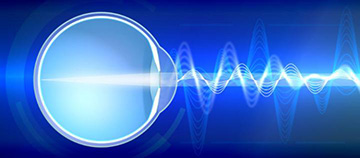
Artist’s view of femtosecond laser pulses arriving in an eye. [Image: © Scientify – UNIGE]
Vision is a complex process, and though the spatial phase of light is known to play a large role, until recently it was assumed that its spectral phase did not. Now, researchers in Switzerland have experimentally confirmed that the shape of light, in addition to its intensity, contributes to image formation on the retina of living mice (Sci. Adv., doi: 10.1126/sciadv.abe1911).
In the future, the University of Geneva (UNIGE) and Ecole Polytechnique Fédérale de Lausanne (EPFL) researchers write, this realization could add a new observable for early diagnostics of ophthalmologic pathologies.
Vision, step-by-step
Visual response begins with light entering the eye and ends with the optic nerve feeding signals to the brain to process as images—with quite a few steps in between. The researchers behind the current work focused on the first step: the ultrafast photoreactions that occur when the molecule retinal interacts with light, triggering the visual process.
Several years ago, scientists showed that these reactions could be controlled with ultrafast pulses by isolating retinal in solution and stimulating the proteins with laser light. But, the Swiss team wondered, could the same be achieved in the complex visual processes of a living animal?
“We have been working for a long time on the quantum coherent control of molecular processes using ultrashort laser pulses,” explains senior author and UNIGE professor Jean-Pierre Wolf, “and we were wondering whether these concepts would work also for modulating some natural physiological function in living animals.”
Perceiving brightness
To test this, Wolf and the members of a multidisciplinary Swiss National Science Foundation project, Quantum Vision, outfitted mice with contact lenses and electrode patches to monitor the animals’ optical nerve signals via electroretinography—a noninvasive process. Using ultrashort pulses generated by a noncollinear optical parametric amplifier, pumped by a Ti:sapphire laser, they then shaped the low-energy laser pulses and investigated the visual response.
The results reportedly showed that light-induced firing in the optical nerve of a mouse could, in fact, be modulated by the chirp in femtoscecond pulses as well as the color. Meaning, Wolf explains, that by only changing the spectral phase in the pulses and keeping the same energy, the perceived brightness is still modified.
“In other words,” says Wolf, “when ultrashort pulses are used, vision is not only sensitive to the number of photons but also to the spectral phase or the temporal pulse shape.”
Quantum light and human vision
As part of the Quantum Vision project, Wolf and his colleagues next plan to investigate the sensitivity of human vision to “exotic light,” such as entangled photon pairs. Future applications for this research might include investigating which degenerative eye diseases are more sensitive to temporal variations than to light amplitude alone.
